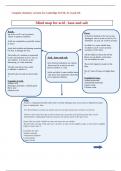Summary
Summary Mind maps of acid, base and salt for Cambridge IGCSE, IGCSE(9-1) and O/L chemistry
- Course
- Chemistry
- Institution
- 10th Grade
The minds maps provide concise knowledge on 1. concepts of acid, base and salts 2. Mind map - acid ( properties, reactions , strength and identification ) 3. Mind map - base ( properties, reactions , strength and identification ) 4. Mind map -salt ( properties, reactions , strength and i...
[Show more]



